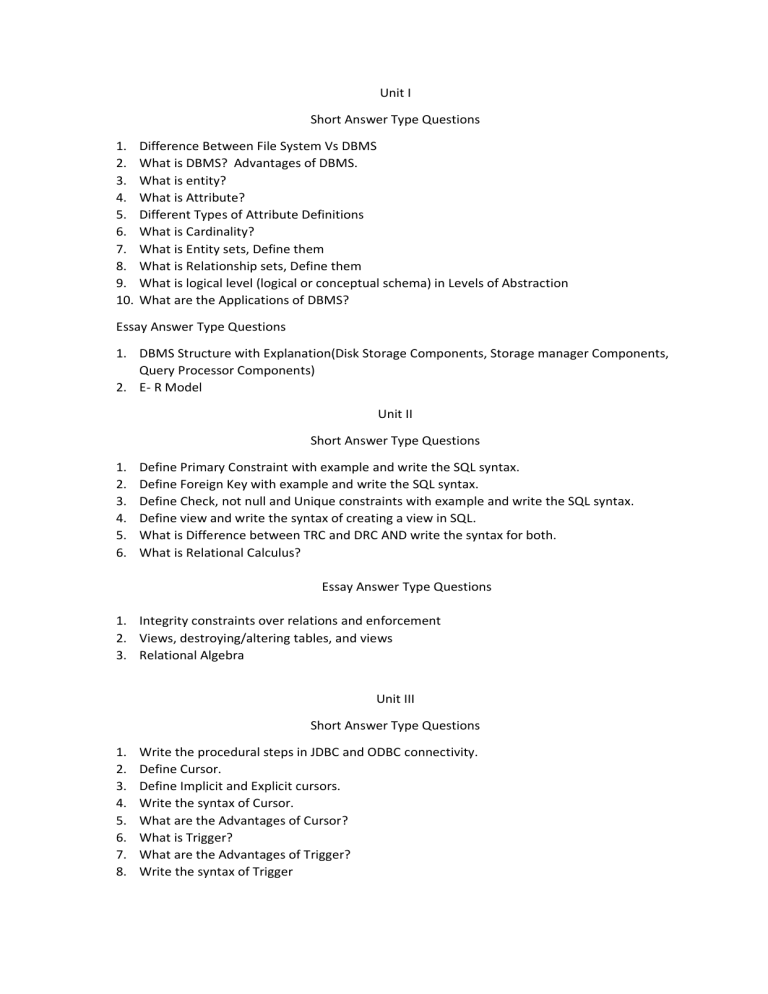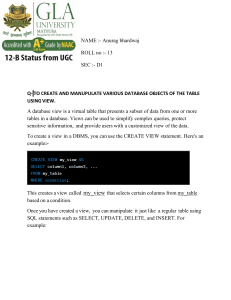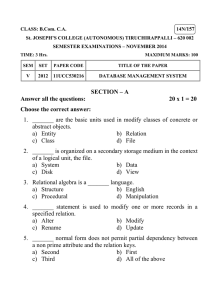DBMS Exam Questions: SQL, Normalization, Concurrency
advertisement

Unit I Short Answer Type Questions 1. 2. 3. 4. 5. 6. 7. 8. 9. 10. Difference Between File System Vs DBMS What is DBMS? Advantages of DBMS. What is entity? What is Attribute? Different Types of Attribute Definitions What is Cardinality? What is Entity sets, Define them What is Relationship sets, Define them What is logical level (logical or conceptual schema) in Levels of Abstraction What are the Applications of DBMS? Essay Answer Type Questions 1. DBMS Structure with Explanation(Disk Storage Components, Storage manager Components, Query Processor Components) 2. E- R Model Unit II Short Answer Type Questions 1. 2. 3. 4. 5. 6. Define Primary Constraint with example and write the SQL syntax. Define Foreign Key with example and write the SQL syntax. Define Check, not null and Unique constraints with example and write the SQL syntax. Define view and write the syntax of creating a view in SQL. What is Difference between TRC and DRC AND write the syntax for both. What is Relational Calculus? Essay Answer Type Questions 1. Integrity constraints over relations and enforcement 2. Views, destroying/altering tables, and views 3. Relational Algebra Unit III Short Answer Type Questions 1. 2. 3. 4. 5. 6. 7. 8. Write the procedural steps in JDBC and ODBC connectivity. Define Cursor. Define Implicit and Explicit cursors. Write the syntax of Cursor. What are the Advantages of Cursor? What is Trigger? What are the Advantages of Trigger? Write the syntax of Trigger Essay Answer Type Questions 1. 2. 3. 4. 5. 6. Procedural SQL All Basic SQL Queries: DDL, DML, TCL, DCL SQL Join Operations Embedded SQL Cursors Triggers Unit IV Short Answer Type Questions 1. 2. 3. 4. 5. What is Schema Refinement? What is normalization? Define 1NF, 2NF, 3NF, BCNF, 4NF and 5NF with examples What is Multi valued Dependency? What is Dependency Preservation? Essay Answer Type Questions 1. All Normal Forms (1NF, 2NF, 3NF, BCNF, 4NF, 5NF) problems. 2. Dependency Preservation and problems. 3. Multi valued Dependency and problems Unit V Short Answer Type Questions 1. 2. 3. 4. What is Concurrency Control? What is Transaction Management What are ACID Properties? All Concurrency Control Problems( Dirty Read, Unrepeatable Read, Lost update Read, Phantom Read) 5. What is View Serializability and its conditions 6. What is conflict serializability and its conditions Essay Answer Type Questions 1. 2. 3. 4. 5. Concurrent Execution of Transactions and Lock-Based Concurrency Control Dealing with Deadlocks 2PL Explain Aries. Crash Recovery



